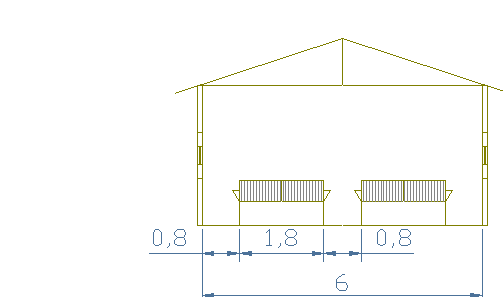 |
| Fig 1. Setting up the coop inside rabbits housing |
|
MEKARN Workshop 2008: Organic rabbit production from forages |
In past few years, the rabbit breeding in Viet Nam is development faster especially in souther areas, the rabbit farms increasing day by day. However, the efficiency of rabbit husbandry in Viet Nam is still limited because of many reasons but the main reason is lack of scheme and technique. Besides, the cage’s design hasn’t been interested enough and still isn’t suitable to Vietnamese weather. Almost rabbit farms in central of Vietnam are small-scale and still not main income of farmers. While climate condition in central of Vietnam is very harsh, it’s one of good condition for development of deases. Hence scheming and building a reasonable model of breading is very important. In addition, research and design cage that suitable to production and weather condition in central of Vietnam is necessary. In this study we are designed some models of housing and equipment that are petinent to rabbit husbandry at small-scale farms and to climate in central of Viet Nam.
Best known for being prolific, rabbits are also herbivores which efficiently convert fodder to food. The whole point of meat production is to convert plant proteins of little or no use to people as food into high-value animal protein. In efficient production systems, rabbits can turn 20 percent of the proteins they eat into edible meat. Comparable figures for other species are 22 to 23 percent for broiler chickens, 16 to 18 percent for pigs and 8 to 12 percent for beef. A similar calculation for the energy cost of these proteins is even more unfavourable to ruminants. When cattle or sheep are raised for meat production, most of the energy consumed by the herd or flock is used to maintain breeding females which have a low prolificacy: a maximum of 0.8 to 1.4 young per year against 40 for female rabbits. Even with the theoretical lower energy cost when cattle are raised for both milk and beef, rabbit meat is still more economical in terms of feed energy than beef. Rabbit meat production is therefore an attractive proposition, especially when the aim is to produce quality animal protein. Rabbits can also easily convert the available proteins in cellulose-rich plants, whereas it is not economical to feed these to chickens and turkeys - the only animals with higher energy and protein efficiency. The traditional grain and soycakes fed to these domestic poultry put them in direct competition with humans for food. For countries with no cereal surpluses, rabbit meat production is thus especially interesting. Up to now rabbit present at almost countries in the world especially in some developing country such as Italy, French, German, the rabbit produce more than 120 thousands of tones per year. In Viet Nam the rabbit farms increasing day by day, but the rabbit production are still low. Up to 2007 the estimated production about 25 thousands of tones and annual consumption of rabbit meat is 0, 27 kg per inhabitants. However, the rabbit husbandry in Viet Nam almost at small-scale farms and there are primaries. However rabbit husbandry in Viet Nam is still spontaneous and because of lack of husbandry communities so produce efficiency is still limited. Moreover, the structure and size of housing unsuitable and so there are affected on rabbit health. But, the limited researching also non research clearly in the effect of structure of housing on rabbit grows. Therefore, the basically of researching in Vietnamese climate condition and biological characteristics of rabbit to study and design housing and equipment is necessary and especially in currently condition in Cnetral areas, where so that rabbit farms will be very good in improve the income for farmers.
Basically for design the rabbit housing.
The design of rabbit coop and install up equipments is governed by the behavioural characteristics of the animals and their reactions to environmental temperature and humidity especially in Central of Viet Nam as the areas has severe weather conditions.
In the past few years, some research have been analysed and others have been mentioned briefly of rabbit behaviour. But they are only an influence on rabbit health so they not are more useful for design rabbit housing. In this study we only introduce some kind of rabbit behaviour such as feeding, environment and hygiene, habitat and breeds, in there we are going to clear the effect of environment on grow of rabbit that is basically on design the housing and rabbit cages. Since the domestication of the rabbit is recent in terms of species evolution (around 200 to 300 generations) the behaviour of the domestic rabbit is still much like that of the wild rabbit. The reactions of wild rabbits will often provide explanations for the problems of housing domestic rabbits and suggest ways of solving them.
Some studies have shown that rabbits will drink and eat at any time in the 24 hours, although they tend to feed nocturnally. Intake is rather slow, even if the animals' feed is rationed. Feed and water should therefore be available over periods of several hours, whether feed is rationed or ad lib. The feed must not be allowed to get dirty, which is inevitable if it is strewn on the ground. From the age of three weeks young rabbits begin to eat the same feed as the doe. Their small size allows them to slip easily into forage racks or dry feed hoppers, so this equipment must be designed to keep them out.
Practically speaking, these features mean that the breeder must provide a drinker and feeding rack for each cage, and perhaps a fodder rack. The rabbits must be able to reach the feeders and fodder racks, as must the caretaker to top them up frequently. An automatic or semi-automatic drinker is easy to make, however. These constraints mean that solid feed distributors are almost always placed in front of the coop, which can easily hinder visibility and accessibility.
There would be no point in reiterating here all the rules of hygiene dealt with in other chapters, particularly preventive hygiene. However, the design of the rabbitry will be heavily influenced by some of these rules.
One of the major rabbit diseases in traditional small-scale production using straw litter is coccidiosis. Contamination is via eliminated with the faeces. Breeders have cut the incidence of this disease by using wire-mesh floors through which the excrement drops.
The wire-mesh flooring system, combined more recently with single, portable, interchangeable cages, has led to considerable progress in disinfecting equipment. Some diseases have been cut down or even wholly eliminated. But not all rabbit breeds can adapt to this type of flooring. Heavy or nervous breeds, in particular, are subject to sore hocks, a bacterial infection developing on the foot pads and irritated by the wire mesh (too much weight per cm2). The risk is greater when the animals are raised in environments with high temperatures (30° to 35°C), or very high humidity (constant relative humidity above 85 percent), or when the rabbits are frequently under stress and thus thump their hind feet on the ground to warn the other rabbits of impending danger. A mesh floor also cannot be insulated, and rabbits are more liable to respiratory ailments if air flow is not controlled. So which have been adapted to mesh flooring, and thus meet modern hygiene standards, or else they rear heavier or more excitable breeds - but then how do they control coccidiosis and other diseases? Today, in some developed countries most new production units use solely wire-mesh coop rabbits. But this implies doing without the genetic pool of other breeds. Would it not be possible to design other types of flooring, recognizing that slatted floors have never been very satisfactory? Whatever the answer, for many developing countries such as Viet Nam the wire-mesh coop will probably remain a theoretical solution for many years to come, until the special mesh necessary is made available to producers at reasonable prices.
Temperature is the most important factor as it directly affects a number of elements. Rabbits have a constant internal (rectal) temperature so heat production and losses must vary to maintain on body temperature. If the ambient temperature is low (below 10°C) the rabbits curl up to minimize the total area losing heat and lower their ear temperature. If the temperature is high (above 30°C), the animals stretch out so they can lose as much heat as possible by radiation and convection, and step up their ear temperature. The ears function like a car radiator. The efficiency of the cooling system depends on the air speed around the animal. At the same time the animal pants to increase heat loss through evaporation of water (latent heat). The sweat glands are not functional in rabbits and the only controlled means of latent heat evacuation is by altering the breathing rate. Perspiration (the evacuation of water through skin) is never great because of the fur. These systems work between 10° and 30°C but when ambient temperatures reach (and mainly when they exceed) 35°C rabbits can no longer regulate their internal temperature and hyperthermia sets in. For newborn rabbits the heat regulation is somewhat different: they have no fur and cannot correctly adjust their food intake as the doe's milk output is the result of an involuntary reaction. At birth they have rather good fat reserves which help them maintain body temperature if two conditions are met. The surrounding temperature must be at least 28°C (30° to 35°C if possible), and they must have other young to huddle against to reduce heat loss.
Rabbits are sensitive to very low humidity (below 60 percent) but not to very high humidity. This may be explained by the fact that wild rabbits spend much of their lives in underground burrows with a humidity level near saturation point (100 percent) while the humility in Viet Nam especially in Central areas verry high. On winter season, the humility usually 90 percent that is too inconvenient for rabbit’s activities. The rabbit has more to fear from abrupt changes in humidity. Constant humidity is therefore the best solution, and this will depend on the housing design. For Viet Nam rabbit the humidity levels around 75 to 80 percent are successful, so we should using auxiliary heating in winter season. However, the temperature and humility have relarionship and have effected together. When the air temperature is too high and humidity is also high, not much latent heat can be exported as water vapour through evaporation. The result is discomfort which can be followed by prostration. Very hot spells with near 100 percent humidity can cause serious problems. Unfortunately this is common in tropical climates during the rainy season. When the temperature is too low and humidity close to saturation point, water condenses on poorly insulated walls, especially at so-called "heat bridges". Water is a good heat conductor and so the cold becomes more penetrating, causing heat loss in the rabbits through convection and conduction. Digestive and respiratory disorders often follow. When the surrounding air is cold, excess humidity modifies the secretion and viscosity of the mucus protecting the upper respiratory apparatus and when air is too dry (relative humidity is below 60 percent) and too hot is even more dangerous. Not only does it upset the secretion of mucus but also the ensuing evaporation shrinks the size of the droplets carrying infection agents, enabling them to penetrate more easily the respiratory apparatus.
The rabbitry must have a certain minimum of ventilation to evacuate the harmful gases given off by the rabbits (CO2), to renew the oxygen and get rid of excess humidity (evaporation, exhalation) and excess heat given off by the rabbits.
Ventilation needs can vary enormously, depending especially on climate, coop type and population density. It is relatively easy and cheap to measure temperature and humidity, but exact air flow measurement requires sophisticated, expensive, hard-to-get equipment such as a hot-wire anemometer. However, the producer can estimate the rate of air flow near rabbits by using a candle flame. High ammonia air levels, 20 to 30 parts per million (ppm), greatly weaken the rabbits' upper respiratory tract and open the door to bacteria such as pasteurella and bordetella. To keep NH3 levels down, ventilation can be increased. The risk is then overventilation, with all the negative consequences illustrated. A more effective solution is to limit NH3 production from fermenting floor litter by removing the litter quickly or keeping it dry. The maximum permissible NH3 content in the air rabbits breathe is 5 ppm.
The effect of lighting
Some studies have been made on the influence of light on rabbit’s health and rabbit activities, and these are almost exclusively concerned with the duration of lighting and seldom with light intensity. Furthermore, practical recommendations on lighting are based more on observations in rabbitries than on experimental findings. Exposure to light for eight out of 24 hours favours spermatogenesis and sexual activity in bucks. Conversely, exposure for 14 to 16 hours a day favours female sexual activity and fertilization. In Viet Nam production all breeding animals of both sexes get 16 hours of light. The slight drop in male sexual activity is amply compensated by good female reproduction rates. The performance is more constant in windowless rabbitries with artificial lighting than in rabbitries which supplement sunlight by artificial lighting. Observations from different rabbitries indicate that breeding does need considerable luminosity, at least 30 to 40 lux. In fact, many breeders who light their premises for 16 hours a day but not uniformly find that the does receiving the least light have the worst reproduction performance. However, for very young rabbits do not really need light, but 15 to 16 hours per day do no harm. Twenty-four-hour lighting, however, can cause disturbances which are hard to explain, such as diarrhoea unrelated to changes in the rate of caecotrophy. So breeders use either sunlight (in rabbitries with windows) or artificial lighting for one or two hours a day to satisfy the young rabbits' needs, at a set time so as not to disturb caecotrophic behaviour. A much weaker light (5 to 10 lux) can be used for young rabbits.
The coop must be clear and clean, the direction is suitable to climate in the tropical and temperate zone. The coop should be made by local material (usually is available and cheap materials). However, when design the housing should be ensure for rabbit easily activities and also unaffected on rabbit heath.
Beside, install any equipment inside the coop has to pertinent with feeding and careing and the structure of coop, some materials are easier to disinfect than others. Wood is very hard to clean, but it can be periodically replaced in countries where it is plentiful such as Viet Nam. Plywood can be disinfected by steeping it in disinfectant solutions. Galvanized iron is easy to clean and disinfect but, unlike wood, is a poor insulator. Concrete, provided it is smooth, can be cleaned and disinfected, but portable concrete installations are virtually ruled out by their weight. Glazed earthenware can be used for some accessories (eg troughs, or even nest boxes). Therefore, the selection material use for rabbits housing depend on each equipment so that is comfortable and pertinent.
The rabbit housing can be made by any material that is easier to find in local and also inexpensive. The temperature more affected on rabbit health so the wall and the roof of housing must be insulated. Usually, design the rabbit housing ceiling and shutter system to reduce the hot weather air inlet, and the building have to right direction (the best of direction Incoterms central of Viet Nam is north to south). Moreover, when design the rabbit housing, we was inlet the door system with purpose controlling the lighting and wind inside the house.
 |
| Fig 1. Setting up the coop inside rabbits housing |
 |
|
Fig 2. Dispose of rabbit housing foundation 1-Food processing areas Incoterms 24 hour, 2- Rood use for take care and food supply, 3-Rabbit coops, 4-Main door, 5- gutter |
|
Table 1: Size of rabbit’s coop and the nest box |
|||||
|
Coop( cm ) |
Nest box ( cm ) |
||||
|
Length |
Width |
Height |
Length |
Width |
Height |
|
90 |
60 |
45 |
60 |
35 |
35 |
|
( big scale ) |
( deliver inside ) |
||||
|
70 |
50 |
35 |
40 |
35 |
30 |
|
( small scale ) |
(deliver inside ) |
||||
|
|
|
|
35 |
25 |
30 |
|
Rabbit coop |
|
(deliver outside ) |
|||
Design the rabbit coop should be depend on animals density and scale produce. The rabbits density as show in table 2.
|
Table 2: Influence of animal density on fattening rabbits |
|||
|
Number of rabbits per m2 |
18.7 |
15.6 |
12.5 |
|
Live weight at 77 days (g) |
2150a |
2327b |
2384b |
|
Average weight gain (g/day) |
32.0a |
36.1b |
36.5b |
|
Average feed intake (g/day) |
111a |
122b |
122b |
|
Intake index |
3.35a |
3.39a |
3.36a |
|
(Note: a, b: on the same line, two values not having the same index letter differ significantly, to the threshold P = 0.05) |
|||
Arcoording to husbandry condition in central of Viet Nam and the technical request of animal coop that are safity in convenient supervision and handling of animals, long life for the material used, animal and producer comfort, no elaborate ventilation system required. so we design the rabbit coop is show in the figure 3.
 |
|
Figure 3. The structure of rabbit coop |
Coop systems vary in accessibility, supervision and comfort for the animals, as well as in convenience of waste removal. Straw-litter coop will be examined first. These are either single level (coop with wooden or plywood framework) or built on several levels (concrete coop, with watertight floor beneath straw litter). The principle is generally the same. Access is by a door in the front of the cage, usually made of mesh, or hardwood latticework that must be replaced fairly often. The other walls have no openings. They must be built in such a way that the rabbits cannot gnaw them. A rabbit cannot chew on a flat wall but will slowly but surely gnaw away any protruding part of the cage that is show in figure 3.
The floor verry important on techniques the coops, in this study we are mentions on the problems of floor there are other advantages and disadvantages with both mesh floors and traditional straw litter. With a mesh floor, through which droppings can fall, automated or very infrequent cleaning is possible because droppings accumulate under the coop. But it also makes the rabbits very dependent on the microclimate or ventilation in the rabbitry. Straw litter, on the other hand, has to be cleaned often (at least once a week) so the producer has to have the material on hand (straw, wood shavings, etc.). An advantage is that a cage with a straw litter floor can be put almost anywhere, as the cage itself partly insulates the animals from variations in the external climate. However, the better for floor of rabbit cages is wire mesh as show in figure 4.
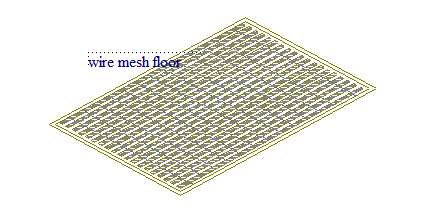 |
| Figure 4. The structure of rabbit coop floor |
Equipment usually uses in the rabbit coop include: feeding trough and racks, drinker, the nest box and rabbit keeping cages. With each the equipment we are design for convenient to rabbit farms in Viet Nam and also in Central areas. Equipment in direct contact with the rabbits or their excrement becomes contaminated by the bacteria, viruses and fungi that accompany the animals. Cages, fittings and building walls must be designed so they can be easily cleaned, disinfected or replaced and not in turn become sources of contamination. Portable components which can be cleaned outside the rabbitry building are especially recommended. Away from the rabbits stronger cleaning agents and more effective methods can be used - powerful disinfectants, lengthy soaking, prolonged exposure to the sun's rays.
Cages should be fitted with troughs (feed hoppers for grain or pellets, small troughs for feed mashes) or forage racks, or both, depending on how the rabbits are to be fed. Troughs must be easy to clean and disinfect, so they should be detachable. Figure 5 shows a hopper for grain or pelleted feed. Troughs and racks should be easy to fill from outside the cage without having to open the access door, but the feed must be protected from bad weather and predators.
 |
|
a, The tray made by iron material b, Glazed earthenware dish Fig 5. The structure of rabbit trough |
The racks should hold at least one day's ration, the hoppers enough for two or three days, and the mash troughs a single ration. The bars of the rack should be strong enough to withstand the rabbits' teeth and keep out the young rabbits, who like to lie on the forage but soil it. The feed hopper should also have a trap to keep the young out. The width between partitions in the feed box should be about 7 to 8 cm for medium breeds. The bars of the racks can be more closely spaced (1 to 2 cm) to prevent waste.
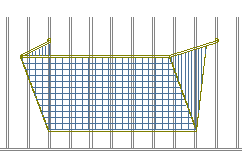 |
| Figure 6. Component of racks |
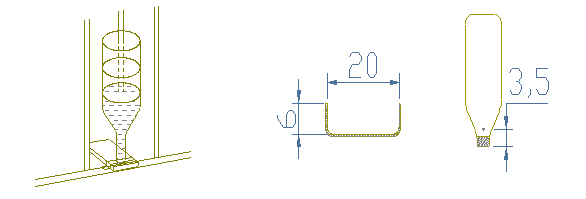 |
|
Figure 7. Rabbit drinker |
A permanent dispenser of clean water is an essential item in each cage, wherever rabbits are not fed green forage alone. Using old cans or glass or earthenware pots as drinkers can create a hygiene problem. Rabbits tend to soil their water, especially if they are reared on straw litter. The drinkers should be fastened so that the rabbits cannot overturn them and so that the breeder can easily clean and refill them once or twice a day. One possible improvement is an inverted water-bottle drinker. A bottle is inverted over a small trough (Figure 7), which is small enough to restrict pollution. The bottle is big so that it needs to be refilled less often and the breeder can see at a glance whether the animals' water intake is normal. Today, for the best solution is an automatic drinker in every coop. The open drinker guarantees that the rabbits will be watered but it is expensive and there is a high risk of water pollution. A nipple drinker requires some learning on the part of the rabbits and wastes water. Even if there is no leak, the rabbits do not drink all the water that drips out but it has hight cost. So usually half that of an automatic open drinker is suitable for husbandry condition in Viet Nam . Above all, it ensures that the rabbits will always have clean water. A nipple drinker is the only kind that can be used if the rabbits are fed meal. Automatic drinkers are fed by water from a low-pressure tank 50 to 150 cm above cage level. This tank can be used to administer medicine with the water. It is usually filled either by water under pressure (automatic watering) or manually (semi-automatic watering). The tank must be in the shade so that the water will not heat, which would be bad for the rabbits.
The nest box should be considered one of the most important items of equipment in rabbit production. It directly affects the viability of the young in the preweaning stage, which is the high-risk mortality period (15 to 40 percent of liveborn rabbits). The job of the nest box is to reproduce conditions in the burrow of a wild doe and protect the young against attacks from the outside environment so that they can get through the first few difficult days of life in optimal comfort. To do this the nest box must:
- allow the doe to kindle and nurse her young in comfort;
- keep the young in a healthy, clean environment;
- prevent dampness from the animals' urine;
- keep the young together in cold weather and help them maintain a constant temperature close to 30° to 35°c in the middle of the nest;
- in hot weather, allow the doe to scatter the nest so that the young can adapt to the temperature;
- keep the young from leaving the nest too early and make it easy for them to get back if they do get out;
- allow the producer to monitor the litter, remove any dead animals, introduce baby rabbits to be fostered and change bedding material easily, without disturbing the doe and the young.
We are design of the the nest box with three dimension are: 30cm x 50cm x 35cm, and have a door with dimension are 18x18cm and located at side and the distance about 15cm from bottom.
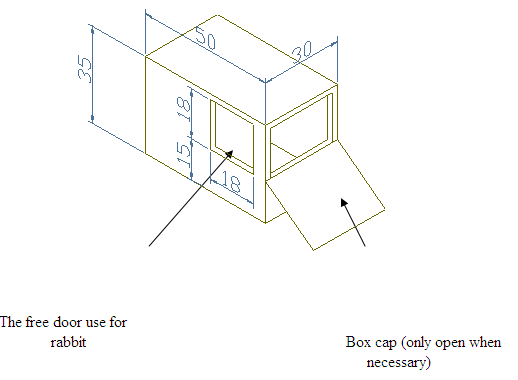 |
| Figure 8. Structure of nest box |
The structure and shape of keeping cages is decisipion in figure 9.
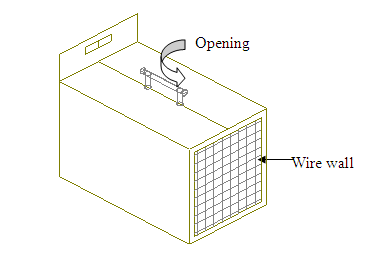 |
|
Fig 10. Structure of rabbit keeping cages |
The research on design rabbit cage is very necessary in Vietnam and in central areas. By collecting data method and reference in some study before us partly built the rabbit husbandry model with the simple hand-made equipments that suitable with small-scale rabbit farms and the husbandry condition in Vietnam.
With some local material such as bamboo, wood or iron we are design the rabbit coop as pertinent to husbandry condition in central of Viet Nam
The spare part is stable, solid and simple. They are easy to remove and to be changed. The dimension of cage is suitable to clean and to disinfect. The rabbit husbandry model is very suitable to direction and the scale of household’s production. This model can make a high economic effect for farms in rural areas.
However, there are still some weakness in this model. The lack of mechanization and automation in husbandry process (for exemple the feeding, watering and cleaning equipement) has limited the effect of model and the capacity for applying this model in large scale industry production.
In conclusion, though the model of rabbit husbandry has come weakness, this model is very suitable to condition production in central of Viet Nam as small-scale farms.
Nguyen Ngoc Nam 2001: Technical of rabbit husbandry. Agricultural Publisher Ha Noi
Dang Tran Dung 2000: Characterictics of rabbit husbandry. Agricultural Publisher Ha Noi
Nguyen Ngoc Nam 2001: Guide on technocal of rabbit food. Agricultural Publisher Ha Noi
Lebas F, Coudert P, de Rochambeau H, Thébault R G The Rabbit - Husbandry. Health and Production,.FAO Animal Production and Health Series No. 21
N T Xmolxki, Dang Duc Dung 1979: Biologycal of meat. Science and Technology Publisher Ha Noi.
Nguyen Phuong Dan 2002: Rabbit meat. Journal of Science and technology. Number 21.
Nguyen Van Hoan 2001: Question and answer on rabbit husbandry. Agriculture Publisher. Ha Noi 2001
Bui Quang Thuan 1982: Study in rabbit husbandry. Science and Technology Publisher Ha Noi .
The rabbit web http://www.rabbitweb.net
Rabbit farming http://www.rabitfarmingweb.com
Food & Drug Administration http://www.fda.gov
American meat Institute http://www.meatami.org
The USDA Website Nutrient Composition http://www.nal.usda.gov/fmic/foodcomp